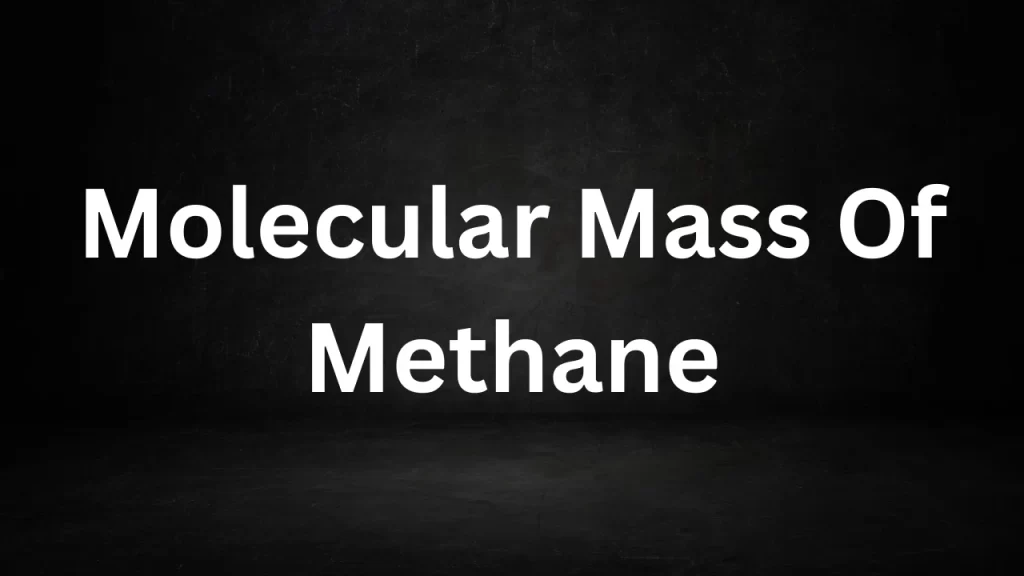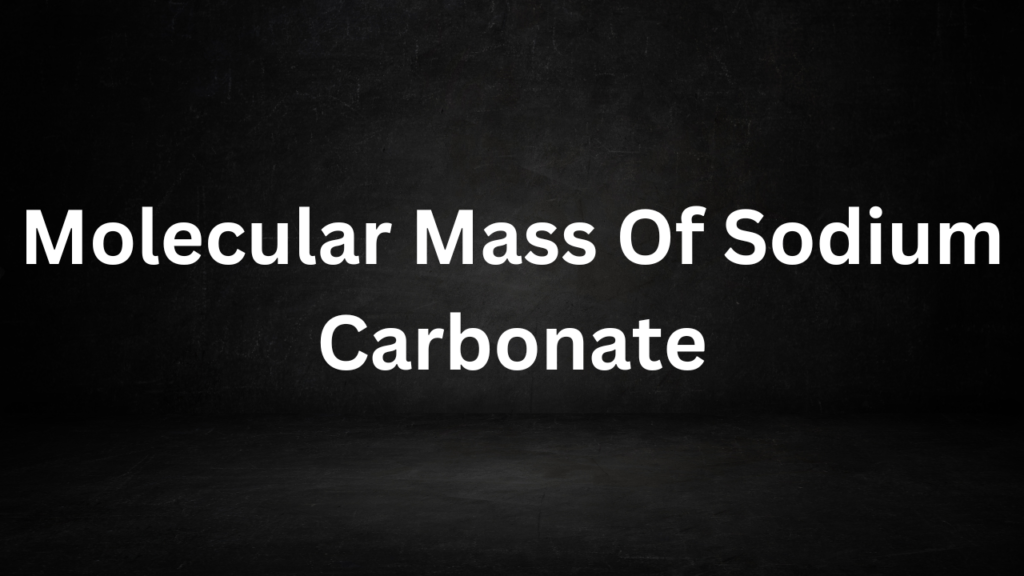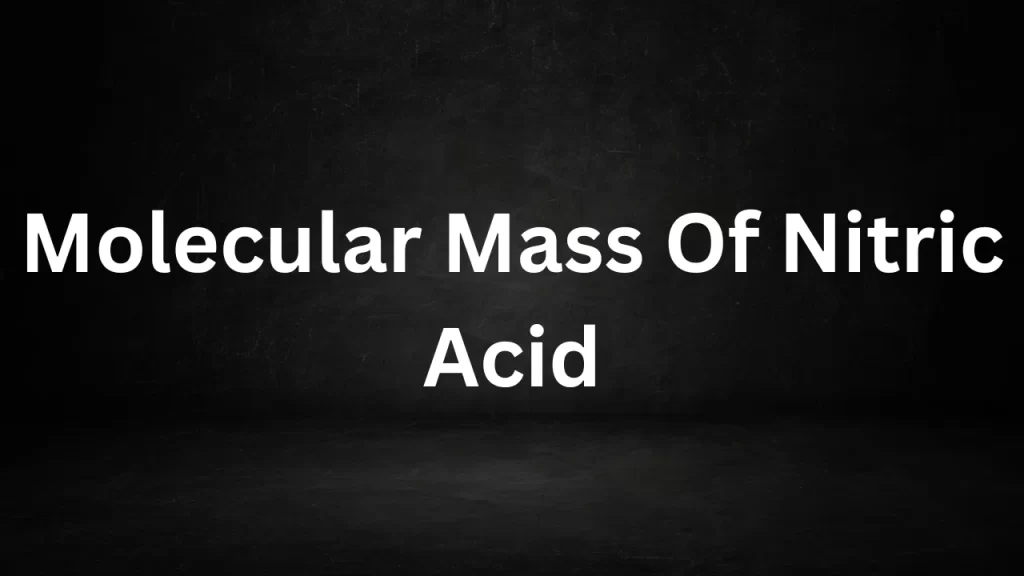Category: Class 9
Molecular Mass Of Iron
Molecular Mass Of Iron: Iron, a metallic element with the chemical symbol Fe and atomic number 26, holds a prominent place in the world of science and industry.
Understanding the mole mass of iron is essential in various applications, from metallurgy to medicine. In this article, we will explore the molecular mass of iron, its significance, and its role in different fields.

Molecular Mass Of Iron
The Nature of Iron
Iron (Fe) is a transition metal known for its remarkable properties, including its high conductivity, malleability, and magnetic properties. It is one of the most abundant elements on Earth and is crucial for the functioning of living organisms.
Calculating the Molecular Mass
Unlike compounds, which consist of multiple elements, the molecular mass of an element is equivalent to its atomic mass. The atomic mass of iron (Fe) is approximately 55.845 atomic mass units (amu).
Significance of Iron’s Molecular Mass
- Metallurgy: Iron’s mole mass plays a pivotal role in metallurgy, where it is used to create various alloys, such as steel. The precise molecular mass is crucial in determining the alloy’s properties, such as strength and corrosion resistance.
- Chemical Reactions: In chemistry, the mole mass of iron is essential for stoichiometry and reaction calculations. It aids in determining reactant ratios and product yields in various chemical processes.
- Medicine: Iron is vital for human health, as it is a key component of hemoglobin, which transports oxygen in our blood. Knowledge of iron’s molecular mass is essential in medical diagnostics and treatments for iron-deficiency anemia.
- Industrial Applications: Iron and its compounds are used in diverse industrial applications, including manufacturing, construction, and electronics. Understanding the molecular mass is vital for quality control and process optimization.
- Geology and Earth Sciences: Iron is a significant component of Earth’s composition. Its molecular mass contributes to the study of geological processes, including the formation of minerals and rocks.
- Space Exploration: Iron is abundant in celestial bodies like Earth, the Moon, and Mars. Its molecular mass is relevant in the study of planetary geology and potential resource utilization in space exploration.
Conclusion
Iron, with its mole mass of approximately 55.845 atomic mass units (amu), is a versatile and indispensable element in various fields, from metallurgy to medicine, industry, and beyond. Its unique properties and abundance make it a cornerstone of human civilization and scientific discovery. As we continue to explore new frontiers and innovations, the molecular mass of iron remains a fundamental parameter in our understanding of the natural world and our technological advancements.
Read More
- Molecular Weight Of NH3
- Molecular Mass Of Methane
- Molecular Mass Of N2
- Molar Mass Of I
- Molecular Weight Of Cl
Frequently Asked Questions (FAQs) On Molecular Mass Of Iron
1. What is the molecular mass of iron?
The mole mass of iron (Fe) is approximately 55.845 atomic mass units (amu).
2. Is the molecular mass of iron the same as its atomic mass?
Yes, for elements like iron, the mole mass is the same as its atomic mass. The atomic mass represents the mass of one atom of iron, and in the case of iron, it’s approximately 55.845 amu.
3. Why is the molecular mass of iron significant in metallurgy?
The mole mass of iron is crucial in metallurgy because it influences the properties of iron alloys, such as steel. Engineers and metallurgists use this value to design and manufacture materials with specific mechanical properties.
4. How is the molecular mass of iron used in chemical reactions?
In chemistry, the mole mass of iron is essential for stoichiometry. It helps determine the amount of iron required in chemical reactions and the products’ yields.
5. What is the role of iron’s molecular mass in human health?
Iron is essential for human health, particularly in the form of hemoglobin, which transports oxygen in the blood. Knowledge of iron’s mole mass is important in medical diagnostics and treatment of conditions like iron-deficiency anemia.
Molecular Weight Of NH3
Molecular Weight Of NH3: Ammonia, represented by the chemical formula NH3, is a compound of significant importance in various fields, including chemistry, agriculture, and industry.
Understanding its mole weight is fundamental for comprehending its role and applications. In this article, we will explore the mole weight of NH3, its composition, and its relevance in different domains.

Molecular Weight Of NH3
The Composition of Ammonia
Ammonia (NH3) consists of a single nitrogen (N) atom bonded with three hydrogen (H) atoms. It is a colorless gas with a distinct pungent odor and is commonly encountered in both natural and industrial settings.
Calculating the Molecular Weight
The molar mass of ammonia (NH3), also referred to as its molecular weight, is determined by adding the atomic masses of nitrogen and hydrogen. The atomic mass of nitrogen (N) is approximately 14.00674 atomic mass units (amu), while the atomic mass of hydrogen (H) is approximately 1.00784 amu.
The mole weight of NH3 can be calculated as follows:
Molecular Weight of NH3 = Atomic Mass of N + 3 × Atomic Mass of H Molecular Weight of NH3 ≈ 14.00674 amu + 3 × 1.00784 amu Molecular Weight of NH3 ≈ 17.03020 amu
So, the mole weight of ammonia (NH3) is approximately 17.03020 atomic mass units (amu) or 17.03020 grams per mole (g/mol).
Significance of Ammonia’s Molecular Weight
- Agriculture: Ammonia is a crucial component of fertilizers. Its mole weight is significant in determining the concentration and dosage of ammonia-based fertilizers used to enhance crop growth.
- Industrial Applications: In industrial applications such as refrigeration, ammonia is utilized as a refrigerant gas. Its molecular weight plays a role in designing efficient cooling systems.
- Chemical Reactions: Understanding the molecular weight of ammonia is essential in chemical reactions, including the synthesis of various nitrogen-containing compounds.
- Environmental Impact: Ammonia is a common air pollutant. Knowledge of its mole weight aids in monitoring and regulating ammonia emissions and their impact on ecosystems.
- Household Products: Ammonia is a common ingredient in various household cleaning products. Its mole weight influences its chemical properties and effectiveness as a cleaner.
Conclusion
Ammonia, with its mole weight of approximately 17.03020 atomic mass units (amu), is a versatile compound with wide-ranging applications. Its significance spans agriculture, industry, chemistry, and environmental science. Whether as a fertilizer, refrigerant, or cleaning agent, ammonia’s molecular weight underpins its role in diverse areas, making it an integral part of our everyday lives and the scientific world.
Read More
- Molecular Mass Of Methane
- Molecular Mass Of N2
- Molar Mass Of I
- Molecular Weight Of Cl
- Molecular Mass Of Sodium Carbonate
Frequently Asked Questions (FAQs) On Molecular Weight Of NH3
1. What is NH3, and why is its molecular weight important?
NH3, commonly referred to as ammonia, is a chemical compound comprising nitrogen and hydrogen elements. Its mole weight is crucial for various applications and chemical calculations.
2. How is the molecular weight of NH3 calculated?
To find the molar mass of NH3, you simply add the atomic masses of its constituent elements, nitrogen (N) and hydrogen (H).
3. What is the molecular weight of NH3 (ammonia)?
The mole weight of ammonia (NH3) is approximately 17.03020 atomic mass units (amu) or 17.03020 grams per mole (g/mol).
4. What role does ammonia’s molecular weight play in agriculture?
Ammonia is a key component in fertilizers. Its molecular weight is important for determining fertilizer concentration and application rates in agriculture.
5. How is ammonia’s molecular weight relevant in industrial applications?
In the field of refrigeration, ammonia serves as a common refrigerant gas. Its molecular weight influences its suitability and efficiency in cooling systems.
Molecular Mass Of Methane
Molecular Mass Of Methane: Methane, the simplest hydrocarbon, is a vital component in the world of chemistry and energy.
Understanding its mole mass is key to comprehending its significance in various scientific, industrial, and environmental contexts. In this article, we will delve into the molecular mass of methane, its composition, and its relevance in diverse fields.

Molecular Mass Of Methane
The Composition of Methane
Methane, represented as CH4, is a hydrocarbon consisting of one carbon (C) atom bonded to four hydrogen (H) atoms. It is the primary component of natural gas and is widely distributed in Earth’s atmosphere, making it a crucial player in the carbon and energy cycles.
Calculating the Molecular Mass
To calculate the mole mass of methane (CH4), we need to consider the atomic masses of carbon and hydrogen. The atomic mass of carbon (C) is approximately 12.011 atomic mass units (amu), while the atomic mass of hydrogen (H) is approximately 1.00784 amu.
The mole mass (also known as molar mass or molar weight) of methane is determined by summing the atomic masses of its constituent elements:
Molecular Mass of CH4 = Atomic Mass of C + 4 × Atomic Mass of H Molecular Mass of CH4 ≈ 12.011 amu + 4 × 1.00784 amu Molecular Mass of CH4 ≈ 16.043 amu
So, the molecular mass of methane (CH4) is approximately 16.043 atomic mass units (amu) or 16.043 grams per mole (g/mol).
Significance of Methane’s Molecular Mass
- Energy Source: Methane is a valuable energy source and is often used as natural gas for heating, electricity generation, and fueling vehicles. Its mole mass is essential for calculating energy content and combustion efficiency.
- Climate Change: Methane is a potent greenhouse gas. Its mole mass plays a role in climate change discussions, as it affects its residence time in the atmosphere and its impact on global warming.
- Chemical Reactions: Understanding the mole mass of methane is crucial in chemical reactions, such as combustion and methane reforming, which are significant in energy production and chemical processes.
- Environmental Monitoring: Researchers use methane’s molecular mass in environmental studies, including the measurement of methane emissions from natural sources and human activities.
- Industrial Processes: Methane’s mole mass is vital in various industrial applications, such as chemical synthesis, metallurgy, and the production of hydrogen and other chemicals.
Conclusion
Methane, with its mole mass of approximately 16.043 atomic mass units (amu), is a fundamental hydrocarbon with diverse applications and implications. It serves as a vital energy source, a contributor to climate change, and a key participant in chemical reactions and industrial processes. As we continue to explore sustainable energy sources and address environmental concerns, the mole mass of methane remains a critical factor in our scientific and technological endeavors.
Read More
- Molecular Mass Of N2
- Molar Mass Of I
- Molecular Weight Of Cl
- Molecular Mass Of Sodium Carbonate
- Molecular Mass Of Nitric Acid
Frequently Asked Questions (FAQs) On Molecular Mass Of Methane
1. What is methane, and why is its molecular mass important?
Methane (CH4) is the simplest hydrocarbon and a major component of natural gas. Its mole mass is crucial for various scientific, industrial, and environmental applications.
2. How is the molecular mass of methane calculated?
To find methane’s molecular mass, add the atomic weights of its elements: one carbon (C) and four hydrogen (H) atoms.
3. What is the molecular mass of methane (CH4)?
The molecular mass of methane is approximately 16.043 atomic mass units (amu) or 16.043 grams per mole (g/mol).
4. Why is methane considered a significant energy source?
Methane, burned as natural gas for heating, power, and vehicles, relies on its mole mass for energy calculations.
5. How does methane contribute to climate change, and what role does its molecular mass play?
Methane is a potent greenhouse gas that traps heat in the atmosphere. Its molecular mass affects its residence time in the atmosphere and its impact on global warming.
Molecular Mass Of N2
Molecular Mass Of N2: Molecular mass, also known as molecular weight, plays a crucial role in understanding the physical and chemical properties of substances.
It is a fundamental concept in chemistry, allowing us to quantify the mass of molecules and compounds. In this article, we will explore the mole mass of N2, or dinitrogen, and delve into why it’s a crucial component in the world of chemistry.

Molecular Mass Of N2
The Basics of Molecular Mass
Before we dive into N2’s molecular mass, let’s briefly review what molecular mass is and how it is calculated. Molecular mass represents the sum of the atomic masses of all the atoms in a molecule. This sum is typically expressed in atomic mass units (amu) or unified atomic mass units (u). To calculate the mole mass of a compound, you add up the atomic masses of all the atoms in the molecule based on the periodic table.
Understanding N2 (Dinitrogen)
N2, or dinitrogen, is the most abundant gas in Earth’s atmosphere, making up approximately 78% of the air we breathe. It consists of two nitrogen atoms (N) bonded together by a strong covalent bond. To determine the mole mass of N2, we need to consider the atomic masses of nitrogen atoms.
The atomic mass of nitrogen (N) is approximately 14.00674 amu. Since N2 contains two nitrogen atoms, we can calculate its mole mass as follows:
Molecular Mass of N2 = 2 × Atomic Mass of Nitrogen (N)
The Molecular Mass of N2 = 2 × 14.00674 amu
Molecular Mass of N2 ≈ 28.01348 amu
So, the mole mass of dinitrogen (N2) is approximately 28.01348 amu.
Significance of N2’s Molecular Mass
- Atmospheric Composition: Understanding the mole mass of N2 is crucial for comprehending the composition of Earth’s atmosphere. Nitrogen gas (N2) makes up the majority of the air, and its molecular mass helps scientists and meteorologists analyze the properties of the atmosphere, including its density and pressure.
- Chemical Reactions: Molecular mass is fundamental in chemical reactions. When chemists balance chemical equations, they take into account the molecular masses of reactants and products to ensure the conservation of mass. N2 participates in a wide range of chemical reactions, including those found in the Haber-Bosch process for ammonia production, as well as combustion reactions in engines and industrial processes.
- Avogadro’s Hypothesis: The mole mass of N2 plays a role in Avogadro’s hypothesis, which states that equal volumes of gases at the same temperature and pressure contain an equal number of molecules. N2 is frequently employed as a standard gas in gas stoichiometry owing to its abundance and precisely known molecular mass.
- Analytical Chemistry: In the field of analytical chemistry, the molecular mass of N2 finds application in methods such as mass spectrometry. It helps researchers identify and quantify unknown substances by comparing the molecular mass of their fragments to known values.
Conclusion
Understanding the mole mass of N2 (dinitrogen) is essential in various fields of science and industry. With a molecular mass of approximately 28.01348 amu, N2 plays a significant role in the composition of Earth’s atmosphere, chemical reactions, and analytical chemistry. This fundamental knowledge helps us better grasp the behavior of gases, the principles of stoichiometry, and the composition of the air we breathe. The mole mass of N2 serves as a cornerstone in the world of chemistry and is a vital concept for anyone studying the natural sciences.
Read More
- Molar Mass Of I
- Molecular Weight Of Cl
- Molecular Mass Of Sodium Carbonate
- Molecular Mass Of Nitric Acid
- Molecular Mass Of Sulphuric Acid
Frequently Asked Questions (FAQs) On Molecular Mass Of N2
1. What is N2, and why is it important to know its molecular mass?
N2, also known as dinitrogen, is a diatomic molecule composed of two nitrogen atoms bonded together. Its mole mass is essential to understand various aspects of chemistry, including chemical reactions, atmospheric composition, and analytical techniques.
2. What is the molecular mass of N2?
The mole mass of N2 is approximately 28.01348 atomic mass units (amu).
3. How is the molecular mass of N2 calculated?
To calculate the mole mass of N2, you add up the atomic masses of the two nitrogen (N) atoms in the molecule. Since the atomic mass of nitrogen is approximately 14.00674 amu, the mole mass of N2 is 2 times this value.
4. Why is N2’s molecular mass important in the field of chemistry?
N2’s molecular mass is crucial because it is involved in various chemical reactions, serves as a reference gas in gas stoichiometry, and plays a role in Avogadro’s hypothesis, which is fundamental in understanding the behavior of gases.
5. How does N2 contribute to Earth’s atmosphere?
N2 is the most abundant gas in Earth’s atmosphere, making up approximately 78% of the air we breathe. Its molecular mass influences the density and pressure of the atmosphere, affecting weather patterns and other atmospheric processes.
Molar Mass Of I
Molar Mass Of I: The mol mass of iodine (I) is a fundamental concept in chemistry and science. Iodine, a chemical element with atomic number 53, belongs to the halogen group in the periodic table.
It is known for its distinctive purple-black color and plays essential roles in various applications, including healthcare, industry, and research. Understanding the molar mass of iodine is pivotal, as it serves as a cornerstone for diverse calculations, chemical reactions, and scientific investigations. In this comprehensive article, we will delve deep into the concept of molar mass, explore the significance of iodine in various fields, and calculate the molar mass of iodine.

Molar Mass Of I
Section 1: Molar Mass – A Foundational Concept
1.1 What Is Molar Mass?
Molar mass, often referred to as molecular weight or molecular mass, is a fundamental concept in chemistry. It represents the mass of one mole of a substance and is typically expressed in atomic mass units (amu) or unified atomic mass units (u). The mole, a unit of measurement used in chemistry, allows scientists to work with large quantities of atoms and molecules, making it a vital concept for calculations and stoichiometry.
Molar mass calculations involve summing the atomic masses of all the constituent atoms in a compound, considering their naturally occurring isotopic proportions. This sum provides the molar mass of the substance, and it plays a crucial role in various aspects of chemistry.
1.2 Significance of Molar Mass
The significance of mol mass in chemistry is multifaceted:
1.2.1 Stoichiometry
Stoichiometry is a branch of chemistry that deals with the quantitative relationships between reactants and products in chemical reactions. Molar mass is essential for stoichiometry as it enables chemists to:
- Balance chemical equations accurately by ensuring that the same number of atoms of each element are on both sides of the equation.
- Determine the quantities of reactants and products involved in chemical reactions.
- Calculate reaction yields, allowing for efficient use of resources in industrial processes.
1.2.2 Chemical Reactions
Molar mass information is indispensable for predicting the behavior of substances in chemical reactions. It aids in:
- Understanding how reactants interact and transform into products.
- Assessing the efficiency and feasibility of chemical reactions.
- Determining the composition of products formed during a reaction.
1.2.3 Analytical Chemistry
Analytical chemistry relies on molar mass measurements for the identification and quantification of substances in various samples. This is crucial in fields such as environmental monitoring, food safety testing, and pharmaceutical quality control.
1.2.4 Laboratory Work
In laboratory experiments, scientists and chemists use molar mass calculations to prepare solutions with specific concentrations accurately. This ensures the reliability of experimental results and the reproducibility of experiments.
Section 2: The Element Iodine (I)
2.1 Iodine: An Elemental Overview
Iodine is a non-metallic chemical element with the symbol “I” and atomic number 53. It belongs to the halogen group in the periodic table, which includes fluorine, chlorine, bromine, and astatine. Iodine is known for several distinguishing characteristics:
- Physical State: At room temperature and pressure, iodine exists as a purple-black solid. However, it can sublimate into a violet vapor when heated without passing through a liquid phase.
- Occurrence: Iodine is relatively rare in Earth’s crust but is present in trace amounts in certain minerals and seawater.
- Biological Importance: Iodine is crucial for human health as it is a key component of thyroid hormones, which regulate metabolism. A deficiency in iodine can lead to thyroid disorders and various health issues.
2.2 Iodine Isotopes
Iodine has several isotopes, each with a different number of neutrons in its nucleus. The two most stable and abundant isotopes of iodine are iodine-127 (127I) and iodine-129 (129I). Iodine-127 is the most common and is non-radioactive, making up about 99.8% of naturally occurring iodine. Iodine-129, on the other hand, is radioactive and occurs in trace amounts.
The presence of multiple isotopes affects the molar mass calculation of iodine, as the weighted average of the isotopic masses must be considered.
2.3 Iodine in the Environment
Iodine is naturally found in soil, seawater, and certain foods. It is an essential nutrient for living organisms, particularly humans. The primary dietary sources of iodine include seafood, iodized salt, and some dairy products.
Iodine deficiency can lead to health problems, including goiter (enlargement of the thyroid gland), cretinism (a developmental disorder), and thyroid dysfunction. To combat iodine deficiency disorders, many countries have introduced iodized salt into their food supply.
Section 3: Calculating the Molar Mass of Iodine
3.1 Atomic Mass of Iodine
To calculate the mol mass of iodine (I), we must consider the atomic mass of the element. The atomic mass of iodine is an average value that accounts for the presence of multiple isotopes, each with a different mass and abundance.
The atomic mass of iodine-127 (the most abundant isotope) is approximately 126.90447 atomic mass units (amu) or unified atomic mass units (u).
3.2 Molar Mass Calculation
The mol mass of iodine is determined by considering the weighted average of the atomic masses of its isotopes, accounting for their respective abundances.
To calculate the mol mass of iodine (I), we use the following formula:
Mol Mass of Iodine (I) = (Mass of 127I × Abundance of 127I) + (Mass of 129I × Abundance of 129I)
In this formula:
- Mass of 127I is approximately 126.90447 amu.
- Abundance of 127I is approximately 99.8% (or 0.998).
- Mass of 129I is approximately 128.90477 amu.
- Abundance of 129I is a small fraction of the remaining percentage (approximately 0.2% or 0.002).
Using these values, we can calculate the mol mass of iodine as follows:
Mol Mass of Iodine (I) = (126.90447 amu × 0.998) + (128.90477 amu × 0.002)
The Mol Mass of Iodine (I) = 126.77303 amu + 0.25781 amu
Mol Mass of Iodine (I) ≈ 126.77303 amu
Therefore, the mol mass of iodine (I) is approximately 126.77303 amu.
Read More
- Molecular Weight Of Cl
- Molecular Mass Of Sodium Carbonate
- Molecular Mass Of Nitric Acid
- Molecular Mass Of Sulphuric Acid
- Molar Mass Of Sulphuric Acid
Frequently Asked Questions (FAQs) On Molar Mass Of I
1. What is the molar mass of iodine (I)?
The mol mass of iodine (I) is approximately 126.77303 atomic mass units (amu) or unified atomic mass units (u).
2. What is molar mass, and why is it important in chemistry?
Mol mass, also known as molecular weight, represents the mass of one mole of a substance and is expressed in atomic mass units (amu) or unified atomic mass units (u). It is essential in chemistry for stoichiometry, balancing chemical equations, and various calculations.
3. How is the molar mass of iodine calculated?
The mol mass of iodine is calculated by considering the weighted average of the atomic masses of its isotopes, accounting for their respective abundances. The primary isotopes of iodine are iodine-127 and iodine-129.
4. What are the isotopes of iodine, and how do they affect its molar mass?
Iodine has several isotopes, with iodine-127 and iodine-129 being the most stable and abundant. The presence of multiple isotopes affects the mol mass calculation, as it considers the masses and abundances of each isotope.
5. What is the significance of the molar mass of iodine in chemistry?
The mol mass of iodine is significant for stoichiometry, allowing chemists to balance chemical equations and determine reactant and product quantities accurately. It also plays a role in chemical reactions, analytical chemistry, and various scientific and practical applications.
Molecular Weight Of Cl
Molecular Weight Of Cl: Chlorine (Cl) is a chemical element with atomic number 17, making it one of the halogens in the periodic table.
It is a highly reactive and essential element used in various industries, including water treatment, chemical manufacturing, and the production of plastics. Understanding the molecular weight of chlorine is fundamental in chemistry, as it aids in various calculations and chemical reactions. In this article, we will explore the concept of molecular weight, discuss its significance in chemistry, and calculate the molecular weight of chlorine.

Molecular Weight Of Cl
Molecular Weight: An Important Concept
Mole weight, also known as molen mass or molar mass, is a crucial concept in chemistry. It represents the mass of one mole of a substance and is typically expressed in atomic mass units (amu) or unified atomic mass units (u). Calculating the molecular weight of a chemical element or compound involves summing the atomic masses of all the constituent atoms according to their proportions in the chemical formula.
Calculating the Molecular Weight of Chlorine
To calculate the mole weight of chlorine (Cl), we can use its atomic mass. The atomic mass of chlorine is approximately 35.45 atomic mass units (amu) or unified atomic mass units (u). Since chlorine exists as single atoms (Cl) and not as diatomic molecules (Cl2), its molecular weight is the same as its atomic mass.
Mole Weight of Chlorine (Cl) = Atomic Mass of Chlorine (Cl) Mole Weight of Chlorine (Cl) = 35.45 amu or 35.45 u
So, the mole weight of chlorine (Cl) is approximately 35.45 amu or 35.45 u.
Significance of Chlorine Molecular Weight
The mole weight of chlorine holds significance in various aspects of chemistry:
- Stoichiometry: Mole weight is essential in stoichiometry, allowing chemists to balance chemical equations and determine the quantities of reactants and products involved in chemical reactions that include chlorine.
- Chemical Reactions: Understanding the mole weight of chlorine aids in predicting its behavior in chemical reactions, calculating reaction yields, and determining product formation.
- Water Treatment: Chlorine is commonly used for water disinfection in municipal water treatment plants. Its molecular weight is important for accurately dosing chlorine to ensure safe drinking water.
- Chemical Manufacturing: Chlorine is a key raw material in various chemical processes, including the production of PVC (polyvinyl chloride) and chlorine-based solvents. Knowledge of its mole weight is crucial for quality control and process optimization.
- Analytical Chemistry: In analytical chemistry, mole weight measurements are often used for the identification and quantification of substances.
Conclusion
The mole weight of chlorine (Cl) is a fundamental concept in chemistry, with practical implications in various applications. By calculating its mole weight, chemists can make informed decisions, conduct precise experiments, and ensure the efficient utilization of chlorine in chemical processes, water treatment, and industrial applications. This understanding highlights the importance of mole weight in chemistry, allowing us to comprehend and control element properties effectively.
Read More
- Molecular Mass Of Sodium Carbonate
- Molecular Mass Of Nitric Acid
- Molecular Mass Of Sulphuric Acid
- Molar Mass Of Sulphuric Acid
- Types Of Motion In Physics
Frequently Asked Quetions (FAQs) OnMolecular Weight Of Cl
1. What is the molecular weight of chlorine (Cl)?
The mole weight of chlorine (Cl) is approximately 35.45 atomic mass units (amu) or unified atomic mass units (u).
2. What is molecular weight, and why is it important in chemistry?
Mole weight, also known as mole mass or molar mass, represents the mass of one mole of a substance and is expressed in atomic mass units (amu) or unified atomic mass units (u). It is crucial in chemistry for stoichiometry, balancing chemical equations, and various calculations.
3. How is the molecular weight of chlorine calculated?
The mole weight of chlorine is the same as its atomic mass, which is approximately 35.45 amu or 35.45 u. Chlorine exists as single atoms (Cl) and does not form diatomic molecules (Cl2).
4. Why is the molecular weight of chlorine significant in chemistry?
The mole weight of chlorine is important for stoichiometry, allowing chemists to balance chemical equations and determine reactant and product quantities accurately. It is also relevant in chemical reactions, water treatment, chemical manufacturing, and analytical chemistry.
5. Is chlorine always in its atomic form (Cl) in chemical reactions?
In most chemical reactions, chlorine exists as individual atoms (Cl) rather than diatomic molecules (Cl2). Therefore, its mole weight is equivalent to its atomic mass.
Molecular Mass Of Sodium Carbonate
Molecular Mass Of Sodium Carbonate: Sodium carbonate, also known as soda ash or washing soda, is a versatile chemical compound with numerous applications, ranging from household cleaning to industrial processes.
In the field of chemistry, understanding the mole mass of sodium carbonate plays a pivotal role in various calculations, especially those related to chemical reactions, stoichiometry, and solution preparations. In this article, we’ll explore molar mass, its significance in chemistry, and calculate the molar mass of sodium carbonate (Na2CO3).

Molecular Mass Of Sodium Carbonate
Molecular Mass: A Foundational Concept
The Molecular mass, also referred to as mole weight or molar mass, is a fundamental concept in chemistry. It denotes the mass of a single mole of a substance, commonly expressed in atomic mass units (amu) or unified atomic mass units (u). To calculate the molar mass of a compound, add the atomic masses of all its constituent atoms, considering their relative proportions.
Calculating the Molecular Mass of Sodium Carbonate
To calculate the mole mass of sodium carbonate (Na2CO3), we must first determine the atomic masses of the elements: sodium (Na), carbon (C), and oxygen (O), and then apply these values to the chemical formula.
- Sodium (Na): The atomic mass of sodium is approximately 22.99 amu.
- Carbon (C): The atomic mass of carbon is approximately 12.01 amu.
- Oxygen (O): The atomic mass of oxygen is approximately 16.00 amu.
Now, let’s calculate the molecular mass of sodium carbonate:
Molecular Mass of Na2CO3 = (2 × Atomic Mass of Na) + (1 × Atomic Mass of C) + (3 × Atomic Mass of O)
The Molecular Mass of Na2CO3 = (2 × 22.99 amu) + (1 × 12.01 amu) + (3 × 16.00 amu)
Molecular Mass of Na2CO3 = 45.98 amu + 12.01 amu + 48.00 amu
Molecular Mass of Na2CO3 = 105.99 amu
So, the molecular mass of sodium carbonate (Na2CO3) is approximately 105.99 amu.
Significance of Molecular Mass of Sodium Carbonate
The mole mass of sodium carbonate holds significant importance in various aspects of chemistry:
- Stoichiometry: Mole mass is crucial in stoichiometry, allowing chemists to balance chemical equations and determine the quantities of reactants and products involved in chemical reactions with sodium carbonate.
- Solution Preparation: In laboratories and industries, knowledge of the mole mass is essential for accurately preparing sodium carbonate solutions with specific concentrations, ensuring precise measurements.
- Industrial Applications: Sodium carbonate is widely used in industries such as glass manufacturing, detergents, and water treatment. Understanding its mole mass is vital for quality control and process optimization.
- Household Uses: Sodium carbonate is commonly found in household cleaning products, and its mole mass can help consumers understand product concentrations and efficacy.
- Safety: Knowing the mole mass of sodium carbonate is essential for handling it safely, especially in industrial and laboratory settings, as it assists in determining appropriate safety protocols and precautions.
Conclusion
The mole mass of sodium carbonate (Na2CO3) is a fundamental concept in chemistry, holding practical importance in various applications. Finding molar mass empowers informed choices, precise experiments, and optimized sodium carbonate use in various contexts. Comprehending this essential parameter amplifies our capacity to utilize sodium carbonate’s versatility across diverse chemical processes and applications.
Read More
- Molecular Mass Of Nitric Acid
- Molecular Mass Of Sulphuric Acid
- Molar Mass Of Sulphuric Acid
- Types Of Motion In Physics
- Kinetic Energy Class 9
Frequently Asked Questions (FAQs) On Molecular Mass Of Sodium Carbonate
1. What is the molecular formula of sodium carbonate?
The mole formula of sodium carbonate is Na2CO3, representing two sodium atoms (Na), one carbon atom (C), and three oxygen atoms (O) in a single molecule.
2. What does molecular mass or molar mass mean in chemistry?
Molecular mass, also known as molar mass, refers to the mass of one mole of a substance and is typically expressed in atomic mass units (amu) or unified atomic mass units (u). It is a fundamental concept in chemistry used for various calculations.
3. Why is the molecular mass of sodium carbonate important in chemistry?
The mole mass of sodium carbonate is essential in chemistry because it helps determine the quantity of sodium carbonate involved in chemical reactions, stoichiometry, and solution preparations.
4. How is the molecular mass of sodium carbonate calculated?
To calculate the mole mass of sodium carbonate (Na2CO3), you sum the atomic masses of all the atoms in its chemical formula, taking into account their respective proportions.
5. What is the molecular mass of sodium carbonate (Na2CO3)?
The mole mass of sodium carbonate is approximately 105.99 amu.
Molecular Mass Of Nitric Acid
Molecular Mass Of Nitric Acid: Nitric acid (HNO3) is a highly corrosive and essential chemical compound used in various industrial applications, including the production of fertilizers, explosives, and cleaning agents.
Understanding nitric acid’s molar mass is crucial in chemistry, impacting stoichiometry, reactions, and laboratory procedures significantly. This article delves into molecular mass, its significance in chemistry, and the calculation of nitric acid’s (HNO3) molecular mass.
Molecular Mass Of Nitric Acid
Molecular Mass: A Fundamental Concept
The Molecular mass, also known as mole weight or molar mass, is a fundamental concept in chemistry. It represents the mass of one mole of a substance and is expressed in atomic mass units (amu) or unified atomic mass units (u). The molecular mass of a compound is calculated by summing the atomic masses of all the atoms in its chemical formula, considering the number of atoms of each element.
Calculating the Molecular Mass of Nitric Acid
To find the molecular mass of nitric acid (HNO3), we sum the atomic masses of hydrogen (H), nitrogen (N), and oxygen (O) within the chemical formula.
- Hydrogen (H): The atomic mass of hydrogen is approximately 1.01 amu.
- Nitrogen (N): The atomic mass of nitrogen is approximately 14.01 amu.
- Oxygen (O): The atomic mass of oxygen is approximately 16.00 amu.
Now, let’s calculate the mole mass of nitric acid:
Molecular Mass of HNO3 = (1 × Atomic Mass of H) + (1 × Atomic Mass of N) + (3 × Atomic Mass of O) Molecular Mass of HNO3 = (1 × 1.01 amu) + (1 × 14.01 amu) + (3 × 16.00 amu) Molecular Mass of HNO3 = 1.01 amu + 14.01 amu + 48.00 amu Molecular Mass of HNO3 = 63.02 amu
So, the mole mass of nitric acid (HNO3) is approximately 63.02 amu.
Significance of Molecular Mass of Nitric Acid
The mole mass of nitric acid is significant for several reasons:Stoichiometry:
- It is crucial in stoichiometry, helping chemists balance chemical equations and calculate the amount of reactants and products involved in chemical reactions involving nitric acid.
- Laboratory Work: In laboratories, scientists use the mole mass to measure and prepare solutions of nitric acid with specific concentrations for experiments and analyses.
- Industrial Applications: Industries rely on the mole mass to ensure precise measurements and control processes involving nitric acid, such as in the production of fertilizers, explosives, and chemical manufacturing.
- Safety Precautions: Understanding the mole mass is essential for handling nitric acid safely, as it helps in determining appropriate safety measures and precautions due to its corrosive nature.
Conclusion
The molar mass of nitric acid (HNO3) is a fundamental concept in chemistry, with essential roles in labs and industries. Calculating molecular mass aids chemists in understanding nitric acid’s behavior and composition, ensuring precise control in chemistry and industry.
Read More
- Molecular Mass Of Sulphuric Acid
- Molar Mass Of Sulphuric Acid
- Types Of Motion In Physics
- Kinetic Energy Class 9
- Molecular Weight of AgNO3
Frequently Asked Questions (FAQs) On Molecular Mass Of Nitric Acid
1. What is the chemical formula for nitric acid?
The chemical formula for nitric acid is HNO3, representing one hydrogen atom (H), one nitrogen atom (N), and three oxygen atoms (O) in a single molecule.
2. What is molecular mass, and why is it important in chemistry?
Molecular mass, also known as mole weight or molar mass, is the mass of one mole of a substance expressed in atomic mass units (amu) or unified atomic mass units (u). It is crucial in chemistry as it helps determine the quantity of substances involved in chemical reactions and stoichiometry.
3. How is the molecular mass of nitric acid calculated?
The mole mass of nitric acid (HNO3) is calculated by adding the atomic masses of hydrogen (H), nitrogen (N), and oxygen (O) atoms in the chemical formula, considering their respective proportions.
4. What are the atomic masses of the elements in nitric acid?
The approximate atomic masses are:
- Hydrogen (H): 1.01 amu
- Nitrogen (N): 14.01 amu
- Oxygen (O): 16.00 amu
5. What is the molecular mass of nitric acid (HNO3)?
The mole mass of nitric acid is approximately 63.02 amu.
Molecular Mass Of Sulphuric Acid
Molecular Mass Of Sulphuric Acid: Sulphuric acid, often spelled sulfuric acid, is a vital compound with a broad range of applications in industry, science, and everyday life.
The molar mass, indicating the total mass of atoms in a single acid molecule, is vital in various chemical procedures. In this article, we will examine the notion of molar mass, its importance in chemistry, and compute the molar mass of H2SO4.

Molecular Mass Of Sulphuric Acid
Molecular Mass: An Essential Concept
Mole mass, also known as molecular weight or molar mass, is a fundamental concept in chemistry. It signifies a molecule’s mass, conveyed in atomic mass units (amu) or unified atomic mass units (u). Molecular mass is computed by summing the atomic masses of all the atoms in the molecule, factoring in their proportions.
Calculating the Molecular Mass of Sulphuric Acid
To determine the molecular mass of H2SO4, we add the atomic masses of hydrogen (H), sulfur (S), and oxygen (O) within the compound’s formula.
- Hydrogen (H): The atomic mass of hydrogen is approximately 1.01 amu.
- Sulfur (S): The atomic mass of sulfur is approximately 32.07 amu.
- Oxygen (O): The atomic mass of oxygen is approximately 16.00 amu.
Now, let’s calculate the molecular mass of sulphuric acid:
Mole Mass of H2SO4 = (2 × Atomic Mass of H) + (1 × Atomic Mass of S) + (4 × Atomic Mass of O) Mole Mass of H2SO4 = (2 × 1.01 amu) + (1 × 32.07 amu) + (4 × 16.00 amu) Mole Mass of H2SO4 = 2.02 amu + 32.07 amu + 64.00 amu Mole Mass of H2SO4 = 98.09 amu
So, the mole mass of sulphuric acid (H2SO4) is approximately 98.09 amu.
Significance of Molecular Mass of Sulphuric Acid
The mole mass of sulphuric acid is significant for several reasons:
- Stoichiometry: Mole mass is crucial in stoichiometry, where it helps chemists balance chemical equations and calculate the amount of reactants and products involved in a reaction.
- Concentration: In laboratories and industries, knowledge of the mole mass is essential for preparing solutions of sulphuric acid with specific concentrations accurately.
- Industrial Applications: The mole mass of sulphuric acid is vital in industries such as the production of fertilizers, petroleum refining, and the manufacture of chemicals and detergents.
- Safety: Understanding the mole mass is important for handling sulphuric acid safely, as it helps in determining appropriate safety measures and precautions.
Conclusion
Sulphuric acid’s molar mass (H2SO4) is a vital chemistry concept with essential roles in diverse practical applications and processes. By calculating the mole mass, chemists can gain insight into the composition and behavior of sulphuric acid in chemical reactions. With its molar mass of about 98.09 amu, sulphuric acid remains crucial in industry and science, underscoring its chemistry significance.
Read More
- Molecular Weight Of HNO3
- Molecular Mass Of Phosphorus
- Molar Mass Of Barium
- Benzoic Acid Molecular Weight
- Molecular Mass Of Cl
Frequently Asked Questions (FAQs) On Molecular Mass Of Sulphuric Acid
1. How is molecular mass used in stoichiometry?
Molecular mass is crucial in stoichiometry to balance chemical equations and determine the quantities of reactants and products involved in a chemical reaction. It helps establish the mole-to-mole relationships between substances.
2. Can the molecular mass of sulphuric acid change during chemical reactions?
No, the mole mass of sulphuric acid remains constant regardless of the chemical reaction. It is an inherent property of the compound and does not change based on reaction conditions.
3. Why is knowledge of the molecular mass of sulphuric acid important in laboratory work?
In laboratory settings, understanding the mole mass of sulphuric acid is crucial for accurately preparing solutions with specific concentrations, ensuring the success of experiments and analyses.
4. What are some common industrial applications of sulphuric acid?
Sulphuric acid is widely used in industries for purposes such as the production of fertilizers, petroleum refining, manufacturing of chemicals and detergents, and as a catalyst in various chemical processes.
5. Is sulphuric acid safe to handle, and how does its molecular mass relate to safety?
Sulphuric acid is highly corrosive and can be dangerous if mishandled. Understanding its molecular mass is essential for safety, as it helps in calculating appropriate safety precautions, handling procedures, and dilutions when necessary.
Molar Mass Of Sulphuric Acid
Molar Mass Of Sulphuric Acid: Sulphuric acid, also spelled sulfuric acid, is a highly important chemical compound with a wide range of industrial applications. Its chemical formula, H2SO4, represents its composition, indicating that it consists of two hydrogen atoms (H), one sulphur atom (S), and four oxygen atoms (O).
Understanding the molar mass of sulphuric acid is essential in various scientific and industrial processes. In this article, we will explore the concept of molar mass, the significance of molar mass in chemistry, and calculate the molar mass of sulphuric acid.

Molar Mass Of Sulphuric Acid
Molar Mass: A Fundamental Concept
The Molar mass is a fundamental concept in chemistry that is crucial for various calculations in the field. It represents the mass of one mole of a substance, and it is expressed in grams per mole (g/mol). The molar mass of a compound is calculated by summing the atomic masses of all the atoms in its chemical formula, taking into account the number of atoms of each element. This value plays a vital role in stoichiometry, where it helps in determining the number of moles, mass, or volume of substances involved in chemical reactions.
Calculating the Molar Mass of Sulphuric Acid
To calculate the molar mass of sulphuric acid (H2SO4), we need to determine the atomic masses of the elements hydrogen (H), sulfur (S), and oxygen (O) and then apply these values to the chemical formula.
- Hydrogen (H): The atomic mass of hydrogen is approximately 1.01 g/mol.
- Sulfur (S): The atomic mass of sulfur is approximately 32.07 g/mol.
- Oxygen (O): The atomic mass of oxygen is approximately 16.00 g/mol.
Now, let’s calculate the molar mass of sulphuric acid:
Mol Mass of H2SO4 = (2 × Atomic Mass of H) + (1 × Atomic Mass of S) + (4 × Atomic Mass of O)
The Mol Mass of H2SO4 = (2 × 1.01 g/mol) + (1 × 32.07 g/mol) + (4 × 16.00 g/mol)
Mol Mass of 2SO4 = 2.02 g/mol + 32.07 g/mol + 64.00 g/mol
The Mol Mass of H2SO4 = 98.09 g/mol
So, the mol mass of sulphuric acid (H2SO4) is approximately 98.09 g/mol.
Significance of mol Mass of Sulphuric Acid
The mol mass of sulphuric acid is significant for several reasons:
- Chemical Reactions: It is crucial for determining the amount of sulphuric acid needed or produced in chemical reactions. By knowing the molar mass, scientists and chemists can calculate the stoichiometry of reactions accurately.
- Laboratory Work: In laboratories, scientists use the mol mass to measure and prepare solutions of sulphuric acid with specific concentrations, making it easier to conduct experiments and analyses.
- Industrial Applications: Industries rely on the mol mass to ensure precise measurements and control processes involving sulphuric acid, such as in the production of fertilizers, detergents, batteries, and various chemical processes.
Conclusion
The mol mass of sulphuric acid (H2SO4) is a fundamental concept in chemistry with practical implications in both laboratory and industrial settings. By calculating the molar mass, chemists can better understand and manipulate chemical reactions, ensuring accuracy and efficiency in various applications. The mol mass of sulphuric acid, approximately 98.09 g/mol, is a key factor in its widespread use across different industries.
Read More
- Molecular Mass Of Phosphorus
- Molar Mass Of Barium
- Benzoic Acid Molecular Weight
- Molecular Mass Of Cl
- Molecular Weight Of N2
Frequently aksed Questrions (FAQs) On Molar Mass Of Sulphuric Acid
1. What is the chemical formula for sulphuric acid?
The chemical formula for sulphuric acid is H2SO4, which represents two hydrogen atoms, one sulphur atom, and four oxygen atoms.
2. What is molar mass, and why is it important in chemistry?
Mol mass is the mass of one mole of a substance and is expressed in grams per mole (g/mol). It is essential in chemistry because it allows chemists to relate the mass of a substance to the number of moles, enabling precise measurements and calculations in chemical reactions and laboratory work.
3. How is the molar mass of sulphuric acid calculated?
The mol mass of sulphuric acid (H2SO4) is calculated by adding up the atomic masses of all the atoms in its chemical formula. For H2SO4, this involves summing the atomic masses of two hydrogen atoms (H), one sulphur atom (S), and four oxygen atoms (O).
4. What are the atomic masses of the elements in sulphuric acid?
The approximate atomic masses are:
- Hydrogen (H): 1.01 g/mol
- Sulphur (S): 32.07 g/mol
- Oxygen (O): 16.00 g/mol
5. What is the molar mass of sulphuric acid (H2SO4)?
The mol mass of sulphuric acid is approximately 98.09 g/mol.
